|

by Hildegarde Staninger, PhD, RIET-1
Integrative Health Systems,
LLC
415 3/4th N. Larchmont Blvd
LA, CA 90004
September-17-2007
from
Rense Website
|
Presented at the National
Registry of Environmental Professionals 2007 Annual
Conference, September 6, 2007, San Antonio, Texas
http://www.nrep.org
|
Abstract
There is an environmental disease on the horizon that will affect
more humans and the environment than any one person will know. Its
environmental impact will be far greater than DDT, PCBs and asbestos
have ever been. It is called Morgellon's: A Nano-911 Foreign
Invader.
It has many names:
...to name a few.
It is silent, smart, glistening
powered by its own transitional metal battery. And when it strikes
its victim it feels like a piece of burning broken glass as it
pierces the skin. Smaller than any of the 150 pieces of a virus
(known as virons), it is invisible to the naked eye. So
silent is it, only the one who has been invaded knows its true
nature.
Marked with the seal of man-made,
self-assembling nano-size materials they can be used in forming
drugs, pharmaceuticals, chemicals, biomaterials, artificial nerves,
artificial brains, pseudo skin and molecular electronics. Yes, it
was patterned after nature's many wonders, but it is still one
hundred percent man-made.
The nano-brew has been let loose from
its scientific flask casting its woes upon an unsuspecting
innocence.
Introduction
to Chemical Foreign Invaders
Plants, humans and other animals are constantly exposed in their
environment to a vast array of chemicals that are foreign to their
bodies. These foreign chemicals, or xenobiotics, can be of natural
origin or they can be man-made. In general, the more lipophilic (fat
loving) compounds are readily absorbed through the skin, across the
lungs, or through the gastrointestinal tract.
Constant or even intermittent exposure
to these lipophilic chemicals could result in their accumulation
within the organism, unless effective means of elimination are
present. Indeed, chemicals can be excreted unchanged into urine,
bile, feces, expired air, and perspiration. Except for exhalation,
the ease with which compounds are eliminated from the body largely
depends on their water solubility. This is particularly true for
non-volatile chemicals that are eliminated in urine and feces, the
predominant routes of elimination.
Lipophilic compounds that are present in
these excretory fluids tend to diffuse into cellular membranes and
are reabsorbed, whereas water soluble compounds are excreted.
Therefore, it is apparent why lipophilic xenobiotics could
accumulate within the body; They are readily absorbed but poorly
excreted.1
Fortunately, animal organisms have developed a number of biochemical
processes that convert lipophilic compounds to more hydrophilic
metabolites. These biochemical processes are termed
biotransformation and are usually enzymatic in nature.
It should be stressed that
biotransformation is the sum of the processes by which a foreign
invader such as a chemical is subjected to chemical change by living
organisms (Figure 1 1).
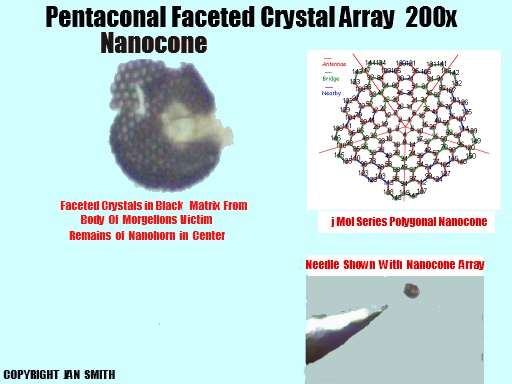
Image No. 1 -
Nanocone Crystal Array
This definition implies that a
particular chemical may undergo a number of chemical changes. It may
mean that the parent molecule is chemically modified at a number of
positions or that a particular metabolite of the parent compound may
undergo additional modification. The end result of the
biotransformation reaction(s) is that the metabolites are chemically
distinct from the parent compound. Metabolites are usually more
hydrophilic than the parent compound.
This enhanced water solubility reduces
the ability of the metabolite to partition into biologic membranes
and thus restricts the distribution of the metabolites to the
various tissues, decreases the renal metabolite(s), and ultimately
promotes the excretion of the chemical by the urinary and biliary
fecal routes.
Morgellons is a disease that affects humans and animals with a
minimum of 93 or more symptoms. Humans experience different colored
fibers growing out of their skin with the presence of lesions that
ooze a gel like material or may have the feeling of hot burning
glass ripping through the underside of their skin as a needle.
Toxicological Pathology evaluations of specimens taken from a
patient who was diagnosed with this disease and was having a knee
replacement operation revealed that the specimen contained silica
and silicone.2
Further analysis of these specimens
using Micro Raman technology revealed that the fibers that grew out
of this same patient were composed of a two part polyester, like a
plastic straw within a straw with a head that was made up of
silicone (Figure 1 -2 & 1-3).
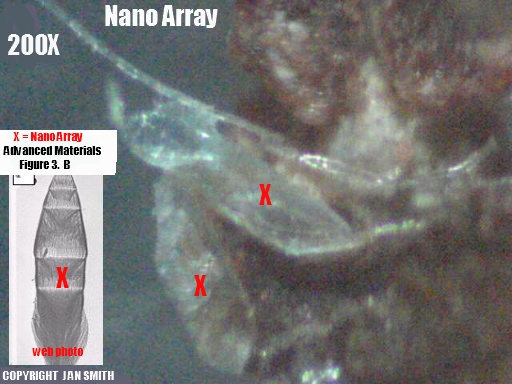
Image No. 2 -Nano
Array
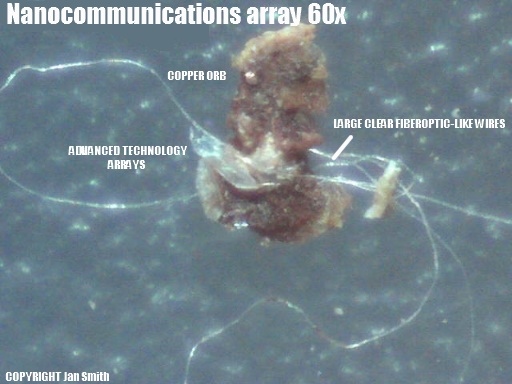
Image No. 3 - View 2
- Nano Array
Polyester is a definite man-made
material. It is "nylon" by another name.
Nylon is a compound that is a lipophatic
compound, just as silicone. In addition, high density polyethylene
fibers were found in a different patient's heel of their foot.
(Figure 1-4).
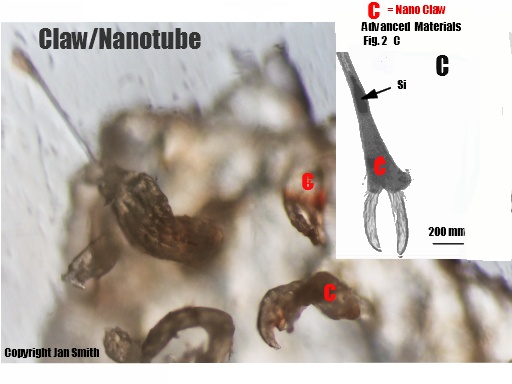
Image No. 4 - Claw/Nanotube
Specimen From Jan's Body
The difference in these compounds
and ones that are man-made in a chemical factory are that they have
a size, which is measured at a "NANO" level.
Nano is nine decimals below the zero or 0.000,000,001.3
It is smaller than the width of a human hair. How can something so
small be so harmful to humans?
Well this is were size counts Big Time. The nano material, which has
many forms such as smart dust, nano gels, quantum dots, nano tube,
nano wire, nano bots, nano horns are all part of the growing field
of
nanotechnology. If something is so small that it does not
stimulate the immune system to react to its foreign invasion of the
cell new cellular toxicological reactions will occur.
Collectively these materials were found
in specimens taken from the same patient who had the knee
replacement operation. The individual had blue fibers that would not
burn at 1,400 degrees F and harden gels that made lesions. The
callus-like scab had cat-like claws on its underside.
These specimens went through
Toxicological Pathology and it is true, a picture says a thousand
words (Figure 1-5).
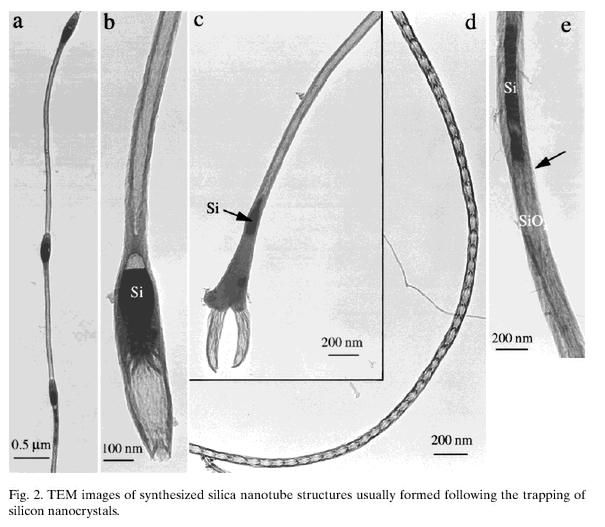
Image No. 5 - Claw/Nanotube
Specimen
No matter what the biological agent,
chemical or foreign invader, the body is geared up to protect itself
and remove the toxic material. The body is not ready for a nano
foreign invader because one can not see it at any level.
Normally the body would go through
biotransformation and remove this toxic material from the body
through biotransformation, but not in the case of Moregellons, which
seems to have a mind of its own as it riddles the body with its
fibers and continuous self- replication.
Normal
Compounds vs. Moregellons through Biotransformation
A number of enzymes in animal organisms are capable of
biotransforming lipid-soluble xenobiotics in such a way as to render
them more water soluble. These enzymatic reactions are of two types;
phase I reactions, which involve oxidation, reduction, and
hydrolysis, and phase II reactions, which consist of conjugation or
synthetic reactions.
Although phase I reactions generally
convert foreign compounds to derivatives that are more water soluble
than the parent molecule, a prime function of these reactions is to
add or expose functional groups (e.g., - OH, - SH, -NH2,
- COOH).
These functional groups then permit the
compound to undergo phase II reactions. Phase II reactions are
biosynthetic reactions where the foreign compounds or a phase I
derived metabolite is covalently linked to an endogenous molecule,
producing a conjugate. In these cases, the endogenous moieties (e.g.
glucuronic acid, sulfate) usually confer upon the lipophilic
xenobiotic or its metabolite increased water solubility and the
ability to undergo significant ionization at physiologic pH.
These conjugated moieties are normally
added to endogenous products to promote their secretion or transfer
across hepatic, renal, and intestinal membranes. The transport
mechanisms that have developed recognize the conjugating moiety.
Thus, the excretion of conjugated xenobiotics is enhanced by their
ability to participate in transport systems that have evolved from
the conjugated products of endogenous molecules.4
The relationship between phase I and phase II reactions is
summarized in Figure 4-1.
The fate of a particular chemical is
determined by its physical/chemical products. Volatile organic
compounds may be eliminated via the lungs with no biotransformation.
Those with functional groups may be conjugated directly, whereas
others undergo phase I reactions before conjugation. As implied,
biotransformation is often integrated and can be complex.
Because of this complexity, imbalances
between phase I and phase II reactions or dose-related shifts in
metabolic routes are often causes of chemical-induced tissue injury.5
Organ and
Cellular Location of Biotransformation
The enzymes or enzyme systems that catalyze the biotransformation of
foreign compounds are localized mainly in the liver. This is not
surprising, since a primary function of the liver is to receive and
process chemicals absorbed from the gastrointestinal tract before
they are distributed to other tissues. Liver receives all the blood
that has perfused the splanchnic area, which contains nutrients and
other foreign substances.
Because of this, the liver has developed
the capacity to extract these substances readily from the blood and
to modify chemically many of these substances before they are
stored, secreted into bile, or released into the general
circulation.
Other tissues can also biotransform
foreign compounds. Nearly every tissue tested has shown activity
toward some foreign chemicals (Figure 1-6).
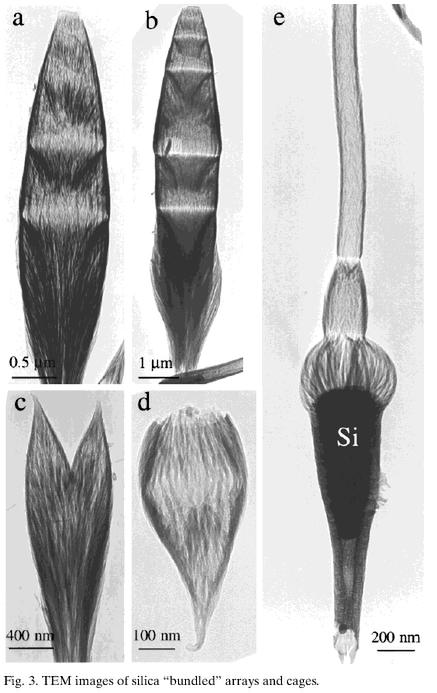
Image No. 6 - Claw/Nanotube
Specimen
Extrahepatic tissues are limited with
respect to the diversity of chemicals they can handle, and thus
their contribution to the overall biotransformation of xenobiotics
is limited.
However, biotransformation of a chemical
within an extrahepatic tissue may have an important toxicological
implication for that particular tissue.6
Subcellular
Localization of Biotransformation Enzymes
Biotransformation of foreign compounds within the liver is
accomplished by several remarkable enzyme systems. These can
chemically modify a wide variety of structurally diverse drugs and
toxicants that enter the body through ingestion, inhalation, the
skin, or injection. The phase I enzymes, those that add or expose
functional groups, are located primarily in the endoplasmic
reticulum, a network of interconnected channels present in the
cytoplasm of most cells.
These enzymes are membrane bound, since
the endoplasmic reticulum is basically a contiguous membrane
composed of lipids and proteins. The presence of enzymes within a
lipoprotein matrix is critical, since lipophilic substances will
preferentially partition into a lipid membrane, the site of
biotransformation. 7
When liver is removed (in the laboratory) and homogenized, the
tubular endoplasmic reticulum breaks up and fragments of the
membrane are sealed off to form micro vesicles. These are referred
to as microsomes, which can be isolated by differential
centrifugation of the liver homogenate. If the supernatant fraction
that results from centrifugation of the homogenate at 9000 x g (to
remove nuclei, mitochondria, and lysosomes as well as unbroken cells
and large membrane fragments) is subjected to centrifugation at
105,00 x g, a pellet highly enriched in microsomes is obtained.
The resulting supernatant fraction,
which contains a number of soluble enzymes, is referred to as
the cytosol. This cytosol contains many of the enzymes of phase II
biotransformation. Many of the important biotransformation enzymes
are referred to as cytosolic or microsomal to indicate the
subcellular location of the enzymes.
The microsomal enzymes that catalyze the phase I reactions were
characterized primarily by their ability to metabolize drugs. Thus,
much of the literature refers to these enzymes as the microsomal, as
the microsomal enzymes will convert drugs to more polar products,
but they also act on the numerous chemicals. Therefore, the word
biotransformation is preferred to drug metabolism, since it conveys
the more universal nature of the reactions.
In addition, if delineates the normal
process of metabolism of endogenous nutrients form the
biotransformation of foreign chemicals.7
Detoxication
Toxication
Inasmuch as both phase I and phase II enzymes convert foreign
chemicals to forms that can be more readily excreted, they are often
referred to as detoxication enzymes. However, it should be
emphasized that biotransformation is not strictly related to
detoxicaiton. In a number of cases, the metabolic products are more
toxic than than the parent compounds.
This is particularly true for some
chemical carcinogens, organo-phosphates, and a number of compounds
that cause cell necrosis in the lung, liver, and kidney. In many
instances, a toxic metabolite can be isolated and identified. In
other cases, highly reactive intermediates are formed during the
biotransformation of a chemical.
The term toxication or bioactivation is
often used to indicate the enzymatic formation of reactive
intermediates.
These reactive intermediates are thought
to initiate the events that ultimately result in cell death,
chemically induced cancer, teratogenesis and a number of other
toxicities (Figure 1-7).
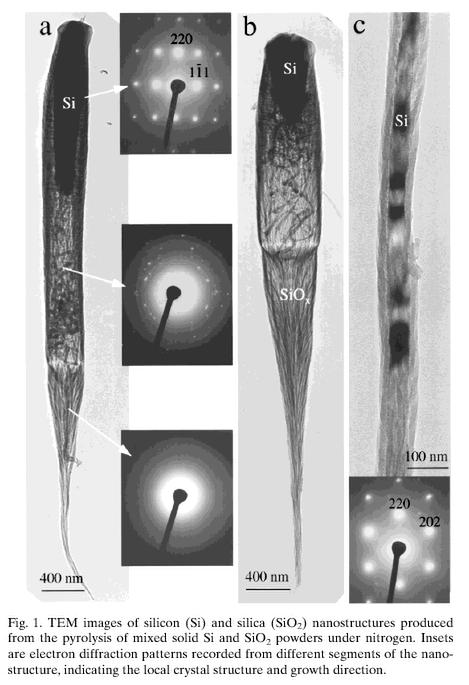
Image No. 7 - Claw/Nanotube
Specimen
Moregellon affected individuals have the
opposite reactions of phase I and II, because they experience
specific physical parameters such as low body temperature, high
blood pressure, urine conductivity high (20 -21), gels, fibers and
fluorescents on the body as nano tattoo fluorescent shapes.
All tell a tale of being injected with a
burning glass needle through their skin as they suffer from severe
itching.
Nanotechnology
Nanotechnology presents new
opportunities to create better materials and products. Already, nano
material containing products are available in U.S. markets including
coatings, computers, clothing, cosmetics, sports equipment and
medical devices. A survey of EmTech Research of companies
working in the field of nanotechnology has identified approximately
80 consumer products, and over 600 raw materials, intermediate
components and industrial equipment items that are used by
manufacturers.
Our economy will be increasingly
affected by nanotechnology as more products containing nano
materials move from research and development into production and
commerce.8
Nanotechnology also has the potential to improve the environment,
both through direct applications of nano materials to detect,
prevent, and remove pollutants, as well as indirectly by using
nanotechnology to design cleaner industrial processes and create
environmentally friendly products. However, there are unanswered
questions about the impacts of nano materials and nanoproducts on
human health and the environment, and the US Environmental
Protection Agency (EPA or "the Agency") has the
obligation to ensure that potential risks are adequately understood
to protect human health and the environment.
As products made from nanomaterials
become more numerous and therefore more prevalent in the
environment, EPA is thus considering how to best leverage advances
in nanotechnology to enhance environmental protection, as well as
how the introduction of nano materials into the environment will
impact the Agency's environmental programs, policies, research
needs, and approaches to decision making. Currently, the only
regulation that addresses to evaluate the environmental risk of nano
materials/technology is the City of Berkley, California.9
Some examples of this technology that applied to a private research
study addressed the composition of the fibers used current
terminology to address the researcher's findings.10
-
Carbon nanotube injectors a
nano carbon nanotube, conjugated with streptavidin-coated
quantum dots. Developed by Xing Chen, Andrax Kis,
Alex Zetti, and Carolyn Bertozzi from University of
California at Berklely. Unique feature is its ability to
deliver genes.
-
Nano motor - Carlo Montemagno
of Cornell University made a molecular motor less than
one-fifth the size of a red blood cell. The key components
are protein from E. coli attached to a nickel spindle and
propeller a few nanometers across, which is powered by ATP,
the energy-intermediate that the body itself uses to power
all living activities. But this molecular motor works with
the efficiency of only 1 to 4 percent, comparing poorly with
those in living organisms that could work at close to 100
percent efficiency.11
-
Nanobombs - Researchers in
Michigan have designed smart "nanobombs" that are said to
evade the immune system, to hone in on diseased cells to
kill them or deliver drugs to them.11
-
Nanoelectrosensor - Electronic
devices that can tell cells to make specific hormones when
the body needs them, and electricity generators that
self-assembling inside the cell.
11
-
Nano-pharmaceuticals Another
idea is to interact directly with cells, so they can be
harnessed as pharmaceutical factories to produce drugs on
demand. Milan Mrksich, chemist at the University of
Chicago, plans to hook up cells to electronic circuits by
tethering them to a carpet of molecular arms. Carbon chains
between 10 to 20 atoms long attached to a gold-plated glass
plate with sulphur atoms. The strands are packed so tightly
that they have to stand upright on the surface. That creates
a thicket of free sticky molecular ends to capture and
manipulate cells.11
Quantum dots, nanoparticles, carbon
nanotubes (in microelectronics) and other throw-away nanodevices may
constitute whole new classes of non-biodegradable nano-junk and
nanosmog, environmental pollutants that could make cancer-causing
asbestos seem tame.11
The prospect of adverse immune reactions has already been pointed
out. Scientists have yet to develop artificial materials that don't
cause at least some problems when inserted into the body, starting
with silicone breast implants.11
Nanoscale devices are worse.
As David Williams an advisor to
the European Union on problems of public perceptions of medical
technologies says,
"The human body is best designed to
repel or attack things the size of a cell."
Worse yet, the devices could clog up our
immune system for good.
And if so small as to not stimulate the immune system at all,
"What
will be the effects upon the cellular membranes, organelles or the
nuclear material (DNA) or its membrane, if the nano material is made up of DNA
plasmids of fungi, bacteria or viruses will this new material mix
and bind to our own internal cell constituents?"
Nano and the
Environment
In the NIOSH white paper on Nano Technology, it specifically
states that the nano material is so small that it will not do any
harm to living cells. Current studies on the use of nano tubes on
rat lungs have shown that the rats become ill or died after the
procedure.12
In
Project FMM two individuals who had Morgellons submitted
samples for analysis using scanning electron microscope technology
along with a sample of a chemtrail cottoncandy-like material that
fell from the sky in Texas. The test revealed that the materials in
all 3 samples were various stages of development or degradation of
the material within the host (Anna and Lily), while the chemtrail
sample matched the ladies'. The samples were over 1,500 miles from
each other.13
Our environment has seen the results of chemicals upon its land,
waters and air. DDT and how it almost whipped out the American
Bald Eagle almost 40 years ago was a perfect example of how a
chemical could do harm in the food chain of other animals. Nano
materials that are dumped into the streams and air are a time bomb
of environmental problems. It is important for both scientists and
the general public to keep a close track on the developments of
nanotechnology and to distinguish the real facts of this technology.
And determine if it can really improve
our lives without compromising our dignity, integrity and the human
race.
REFERENCES
1. Amdur, Mary O., J. Doull, and
C.D. Klaassen. Casarett and Doull's Toxicology: The Basic
Science of Poisons, 4th Edition. Chapter 4: Biotransformation of
Toxicants by I. Glenn Sipes and A. Jay Gandolfi. Pergamon Press.
New York. © 1991. Pgs. 88 126.
2. Staninger, Hildegarde. Far-Infrared Radiant Heat (FIR RH)
Type Remediation for Mold and Other Unique Diseases. National
Registry of Environmental Professionals. Annual Conference in
Nashville, Tennessee. NREP, Des Plaines, IL © October 18, 2006,
http://www.dldewey.com/stan.htm
3. Staninger, Hildegarde. 'Size
Matters' March
2007
4. Dutton, G.J. Glucuronidation of Drugs and Other Compounds.
CRC Press, Inc.. Boca Raton, FL. © 1980
5. Guengerich, F.P. and Liebler, D.C. Enzymatic activation of
chemicals to toxic metabolites. CRC Crit. Rev. Toxicol.
14:259-307. © 1985
6. Hawkins, D.R. (ed): Biotransformaitons. Vol. 1: A Survey of
the Biotransformations of Drugs and chemicals in Animals. Royal
Society of Chemistry. London. © 1988
7. Weber, W.W. The Acetylator Genes and Drug Response. Oxford
University Press. New York. © 1987
8. U.S. EPA Environmental Protection Agency. External Review
Draft Nanotechnology White Paper. Science Policy Council. U.S.
EPA, Washington, D.C. December 2, 2006, http://www.epa.gov/osa/nanotech.htm
9. City of Berkley, California County Commissioner's Meeting.
Testimony of Dr. Edward Spencer and other public citizens on the
risk of
nanotechnology to the environment. (City developed an
ordinance/regulation to evaluate the risk to the environment
from nanotechnology.) Berkley, California © 2006, http://www.seektress.com/berkeley.htm
10. Staninger, Hildegarde.
Project: Fiber, Meteroite &
Morgellons. Phase I and II. March 2007.
11. Ho, Mae-Wan. Nanotecnology, a Hard Pill to Swallow. http://www.i-sis.org.uk/nanotechnology.php
© July 16, 2007
12. Lam, et. al. Pulmonary Toxicity of Single-Walled Carbon
Nanotubes in Mice 7 and 90 Days after Intratracheal
Instillation. Toxicol. Sci. 77:126-134 © 2004
13. Staninger, Hildegarde. Project: Fiber, Meteroite &
Morgellons. Phase I and II. © March 2007
14. Environmental Defense Fund & Dupont. Brochure: NANO Risk
Framework. (www.dupont.com & www.environmentaldefensefung.com)
MORGELLONS
A NANO-911 FOREIGN INVADER
22-Sep-2007
from
Metacafe Website
There is an environmental disease on the horizon that will affect
more humans and the environment than any one person will know. Its
environmental impact will be far greater than DDT, PCBs and asbestos
have ever been.
It is called Morgellons: A Nano-911 Foreign Invader.
It has many names - fiber disease, mystery disease, delusional parasitosis and unknown dermatological skin disorder, to name a few.
There are 93 exhibiting symptoms. It is silent, smart, glistening -
powered by its own transitional metal battery. And when it strikes
its victim it feels like a piece of burning broken glass as it
pierces the skin.
Smaller than any of the 150 pieces of a virus
(known as virons), it is invisible to the naked eye. So silent is
it, only the one who has been invaded knows its true nature. Marked
with the seal of man-made, self-assembling nano-size materials they
can be used in forming drugs, pharmaceuticals, chemicals,
biomaterials, artificial nerves, artificial brains, pseudo skin and
molecular electronics.
Yes, it was patterned after nature's many
wonders, but it is still one hundred percent man made. The nano-brew
has been let loose from its scientific flask casting its woes upon
an unsuspecting innocence.
Morgellons: Nano-911 A Foreign Invader
(above report) by
Dr. Hildegarde Staninger presented at the National Registry of
Environmental Professionals 2007 Annual Conference, September 6,
2007, San Antonio, Texas.
|







